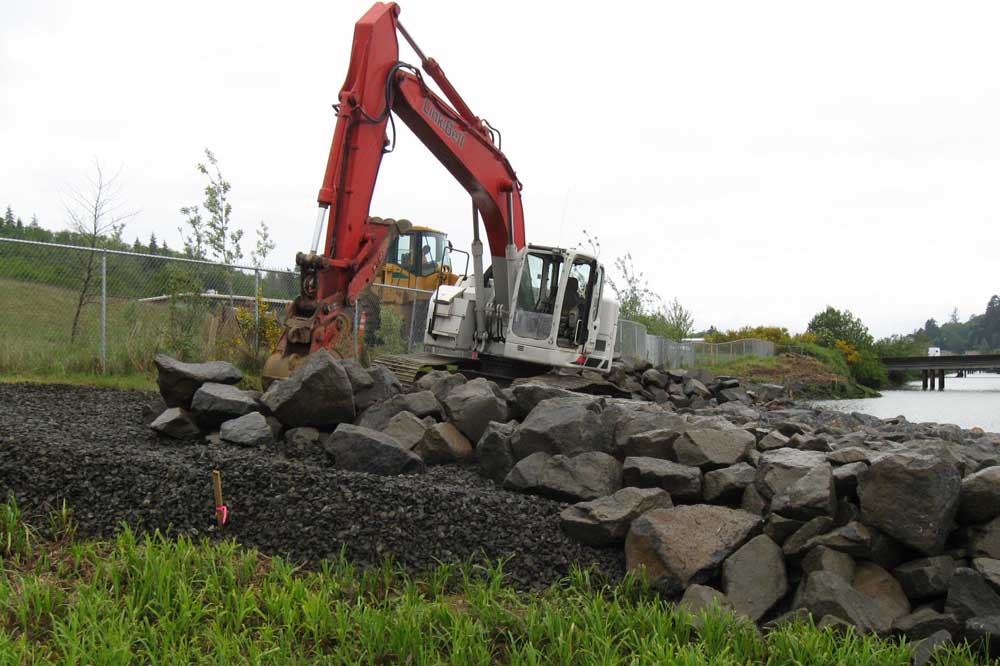Former Navy landfill capped in place at Tongue Point
Published 1:59 pm Monday, December 10, 2018

- The Army Corps of Engineers added riprap in the area of bank erosion along the shore of the Tongue Point landfill to prevent seepage of contaminants into the Columbia River.
Just south of the industrial docks at North Tongue Point, behind locked gates, is a vegetated hill filled with liquid and solid waste from mothballed Navy ships, all capped in place in perpetuity.
Trending
After more than a decade of cleanup, the U.S. Army Corps of Engineers, the state Department of Environmental Quality and the Department of State Lands have signed an agreement to keep the former Tongue Point Naval Air Station Landfill in passive restoration for the foreseeable future.
Clatsop County originally deeded the Department of Defense land in 1921 for a submarine and destroyer base that never became fully active. The tidal flats around the island were filled in using dredge spoils from the Columbia River before World War II for conversion into the Tongue Point Naval Air Station, which eventually grew to encompass 840 acres.
At the south end of the base, near the mouth of Mill Creek, was a landfill operated by the military until the naval air station was deactivated in 1962. The property was transferred to the state in 1980. Investigation of a cleanup began in 1992 after the discovery of groundwater contaminated with heavy metals and PCBs above limits for safe drinking water.
Trending
The site included an estimated 45,000 gallons of oil, fuel, sludge, paints, solvents and other ground contaminants while maintaining and mothballing a fleet of ships after the war. Over the years, it has also taken in metal, wood, building, machine shop and other solid wastes, along with anything from large appliances to dinnerware. The Corps of Engineers was brought on to oversee cleanup of the site.
Cap in place
The Corps and the state eventually settled on a plan to cap the pollution in place, prevent any leaks and restrict access to the site. Over the past decade, contractors for the Corps excavated much of the waste at the landfill and concentrated it into the middle of the property. The shore around the landfill was restored with more than 20,000 cubic yards of new soil and armored riprap to prevent erosion.
A protective clay wall was built around the landfill, along with a cap over the contaminated soils. A collection of pipes was installed to prevent gas buildup underground, along with monitoring wells.
A series of trenches and sumps had been built into the landfill to collect contaminated liquids and separate them for offsite disposal. The system was designed to recover about one-quarter of the contaminated liquids at the site over the last decade, but gathered less than 1,300 gallons before being removed.
The cost of the cleanup is estimated at $810,000, funded by Congress through funds the Corps uses to clean up former defense sites. Operation and maintenance of the site over the next 30 years is expected to cost nearly $1.3 million.
Mirek Towster, a project manager with the Corps , said the cleanup is now largely in the long-term monitoring phase, aside from some underground storage tanks and pipes that still need to be addressed in future projects.
“We do inspect and maintain it, potentially in perpetuity,” he said.
New life
To the north of the landfill, Hyak Maritime is developing a boat repair and fabrication facility. Marine contractor Bergerson Construction recently relocated from the central waterfront and has filled the area just north of the landfill with its equipment.
The deed restrictions signed between the Corps and the state tightly control access to the former landfill and limit any use that would endanger the cleanup. There is not much chance of the property ever being developed, unless the government decides to dig up and remove all the buried contaminants, Towster said.
Much like a Superfund cleanup overseen by the U.S. Environmental Protection Agency, the state Department of Environmental Quality provides secondary oversight, said Laura Gleim, a spokeswoman for the department.
The landfill is one of several former defense sites that have been cleaned up around the region, including two active and five inactive sites at Tongue Point used for munitions, ship berthings, arms testing, underground storage tanks and other vestiges of the naval air station.
The region includes several other restored defense sites at the Coast Guard’s Aids to Navigation Team on Tongue Point, the Emerald Heights Apartments, the Astoria Regional Airport, Camp Rilea and Fort Stevens.









